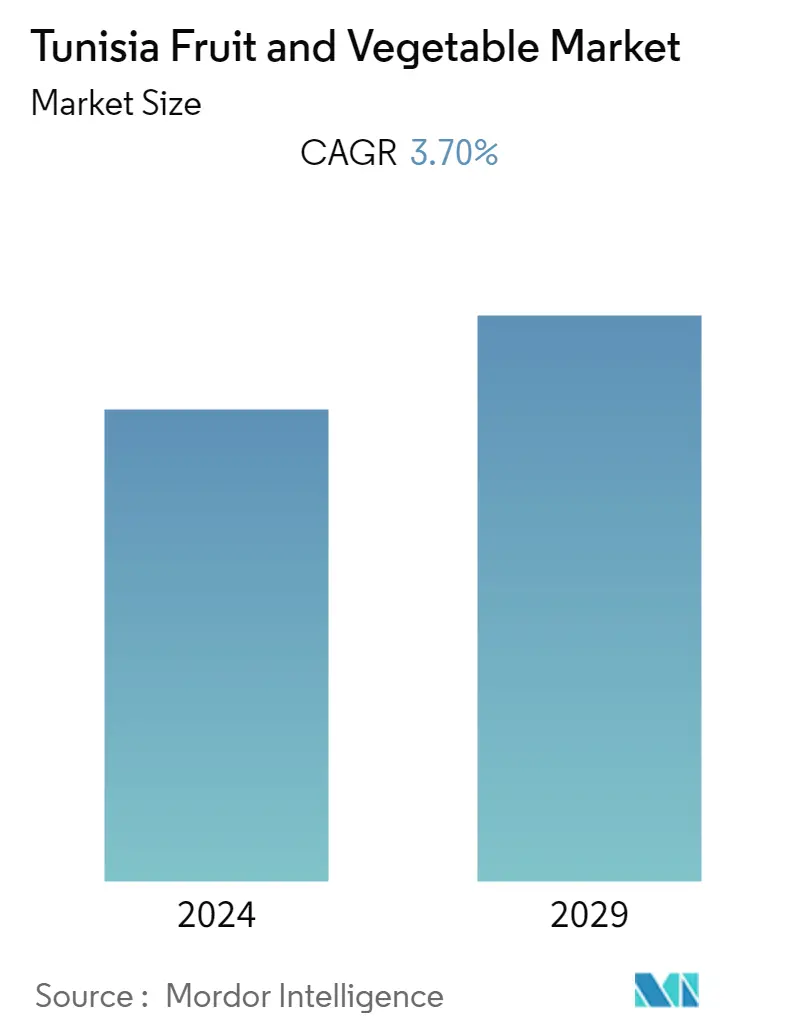Market Size of Tunisia Fruit and Vegetable Industry

| Study Period | 2019 - 2029 |
| Base Year For Estimation | 2023 |
| Forecast Data Period | 2024 - 2029 |
| Historical Data Period | 2019 - 2022 |
| CAGR | 3.70 % |
Major Players*Disclaimer: Major Players sorted in no particular order |
Tunisia Fruit and Vegetable Market Analysis
The Tunisian fruit and vegetable market is projected to register a CAGR of 3.7% during the forecast period.
- Increasing consumer demand for affordable fruits such as bananas, oranges, and naartjie, as well as increased demand for derived products such as fruit juices and jams, with rising consumer expenditure on fresh vegetables, have led to the expansion of the fruits and vegetables market in the country.
- The Tunisian fruit and vegetable market is one of the strategic sectors of the country's economy. In 2021, Tunisia produced 3.13 million metric tons of vegetables, 1,41 million metric tons of tomatoes, and 345,000 metric tons of dates. Tunisian agriculture will contribute to 9.1% of the GDP in 2021. Olives, dates, and fresh fruits are grown for international and domestic consumption. Agricultural produce contributes to 6.0% of the total export earnings in the region.
- Furthermore, Tunisia is the second-largest exporter of organic products, with an area of 297,137 hectares in 2021. Its share of total agricultural land is 3.0%, mainly olive, date, vegetable, aromatic, medicinal plants, and vines. About 80.0% of the Tunisian organic produce is exported, and it is the only African country that has the recognition of equivalence with the EU and Switzerland pertaining to organic agriculture.
Tunisia Fruit and Vegetable Industry Segmentation
The changing agro-climatic factors of the Mediterranean region have favored the development of different fruit trees and nuts in Tunisia. The country also produces fruit crops, such as citrus, grape, pomegranate, apple, and peach, and among vegetables, it produces potato, tomato, pepper, onion, and artichoke.
The Tunisian fruit and vegetable market is segmented by type (fruit and vegetables). The report includes production analysis (volume), consumption analysis (value and volume), export analysis (value and volume), import analysis (value and volume), and price trend analysis.
The report offers market size and forecast in terms of value in USD million and volume in metric tons for the above-mentioned segments.
| Type (Production Analysis by Volume, Consumption Analysis by Volume and Value, Import Analysis by Volume and Value, Export Analysis by Volume and Value, and Price Trend Analysis) | |
| Vegetables | |
| Fruits |
Tunisia Fruit and Vegetable Market Size Summary
The Tunisian fruit and vegetable market is a vital component of the country's economy, driven by increasing consumer demand for affordable fruits and fresh vegetables. This sector is experiencing growth due to rising consumer expenditure and the demand for derived products like fruit juices and jams. Tunisia's strategic agricultural production, including olives, dates, and fresh fruits, supports both domestic and international markets, contributing significantly to the country's GDP and export earnings. The country's recognition in organic agriculture, particularly its equivalence with the EU and Switzerland, further enhances its export potential. Tunisia's dry climate and geographical proximity to major international markets, such as Europe and the MENA region, bolster its position as a key exporter of dried fruits and other agricultural products.
The market's expansion is supported by factors such as market liberalization, improved rural transport infrastructure, and investment incentives. Tunisia's vegetable production surpasses that of fruits, with tomatoes and potatoes being significant staples. The cultivation of processing tomatoes is a strategic focus, involving a substantial number of farmers and extensive agricultural land. The rising consumption of fresh tomatoes and the promotion of sustainable agricultural practices are key drivers of market growth. Additionally, Tunisian exports of fruits and vegetables, particularly to neighboring countries like Libya, have seen notable increases, highlighting the region's growing trade dynamics.
Tunisia Fruit and Vegetable Market Size - Table of Contents
-
1. MARKET DYNAMICS
-
1.1 Market Overview
-
1.2 Market Drivers
-
1.3 Market Restraints
-
-
2. MARKET SEGMENTATION
-
2.1 Type (Production Analysis by Volume, Consumption Analysis by Volume and Value, Import Analysis by Volume and Value, Export Analysis by Volume and Value, and Price Trend Analysis)
-
2.1.1 Vegetables
-
2.1.2 Fruits
-
-
Tunisia Fruit and Vegetable Market Size FAQs
What is the current Tunisia Fruit and Vegetable Market size?
The Tunisia Fruit and Vegetable Market is projected to register a CAGR of 3.70% during the forecast period (2024-2029)
What years does this Tunisia Fruit and Vegetable Market cover?
The report covers the Tunisia Fruit and Vegetable Market historical market size for years: 2019, 2020, 2021, 2022 and 2023. The report also forecasts the Tunisia Fruit and Vegetable Market size for years: 2024, 2025, 2026, 2027, 2028 and 2029.

